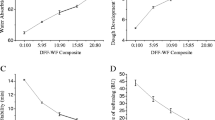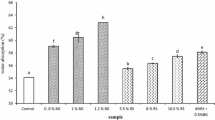Abstract
Currently, consumers’ preference toward baked goods with additional (functional and nutritional) value is increasing, leading food industries to look at natural nutrient-dense alternatives like tef grain. Impact of tef grain flour incorporation (three Ethiopian varieties: DZ-01-99, DZ-Cr-37 and DZ-Cr-387 at 10, 20, 30 and 40 % levels) on dough viscoelastic profiles and stickiness of wheat-based dough matrices were investigated. Oscillatory and creep–recovery tests together with dough stickiness were performed. Incorporation of tef flours affected the structure of the dough matrices visibly by reducing viscoelastic moduli, and the maximum stress doughs can tolerate before its structure is broken and increased dough instantaneous and retarded elastic compliances. Effect of dose was not always significant in the parameters measured. Tef grain flour incorporation up to 30 % level led to breads with higher loaf volume than the control associated with optimal consistency and higher deformability of doughs. Higher tef doses increased dough stickiness. This will affect dough handling and shaping/flattening to get continuous strands or thin sheets. On average, the DZ-Cr-37-supplemented doughs exhibited higher elastic and viscous moduli, lower compliances and higher steady-state viscosity and led to significantly lower loaf bread volumes. Hence, based on dough viscoelastic and stickiness properties, incorporation of DZ-01-99 and DZ-Cr-387 into wheat flour-based formulations could be more preferable.

Similar content being viewed by others
References
Abebe W, Ronda F (2014) Rheological and textural properties of tef [Eragrostis tef (Zucc.) Trotter] grain flour gels. J Cereal Sci 60:122–130
Abebe W, Collar C, Ronda R (2015) Impact of variety type and particle size distribution on starch enzymatic hydrolysis and functional properties of tef flours. Carbohydr Polym 115:260–268
Adebowale AA, Emmambux MN, Beukes M, Taylor JRN (2011) Fractionation and characterization of teff proteins. J Cereal Sci 54:380–386
Alaunyte I, Stojceska V, Plunkett A, Ainsworth P, Derbyshire E (2011) Improving the quality of nutrient-rich teff (Eragrostis tef) breads by combination of enzymes in straight dough and sourdough bread making. J Cereal Sci 55:22–30
Armero E, Collar C (1997) Texture properties of formulated wheat doughs. Relationships with dough and bread technological quality. Z für Lebensm Unters Forsch 204:136–145
Baye K (2013) Food-based strategies to enhance iron and zinc bioavailability of complementary foods consumed by young children in Ethiopia. Ph.D. dissertation, University of Montpellier
Bultosa G, Hall AN, Taylor JRN (2002) Physico-chemical characterization of grain tef [Eragrostis tef (Zucc.) Trotter] starch. Starch/Stärke 54:461–468
Bultosa G (2007) Physicochemical characteristics of grain and flour in 13 tef [Eragrostis tef (Zucc.) Trotter] grain varieties. J Appl Sci Res 3:2042–2051
Chen WZ, Hoseney RC (1995) Development of an objective method for dough stickiness. LWT Food Sci Technol 28:467–473
Dekking LS, Winkelaar YK, Koning F (2005) The Ethiopian cereal tef in celiac disease. The N Engl J Med 353:1748–1749
Dobraszczyk BJ, Morgenstern MP (2003) Rheology and the breadmaking process. J Cereal Sci 38:229–245
Edwards NM, Dexter JE, Scanlon MG (2001) The use of rheological techniques to elucidate durum wheat dough stretch properties. Fifth Ital Conf Chem Process Eng Florence Ital 2:825–830
Grausgruber H, Hatzenbichler E, Ruckenbauer P (2003) Analysis of repeated stickiness measures of wheat dough using a texture analyzer. J Texture Stud 34:69–82
Hager AS, Wolter A, Jacob F, Zannini E, Arendt EK (2012) Nutritional properties and ultra-structure of commercial gluten free flours from different botanical sources compared to wheat flours. J Cereal Sci 56:239–247
Lazaridou A, Duta D, Papageorgiou M, Belc N, Biliaderis CG (2007) Effects of hydrocolloids on dough rheology and bread quality parameters in gluten-free formulations. J Food Eng 79:1033–1047
Masi P, Cavella S, Sepe M (1998) Characterization of dynamic viscoelastic behavior of wheat flour doughs at different moisture contents. Cereal Chem 74:428–432
Mohammed MIO, Mustafa AI, Osman GAM (2009) Evaluation of wheat breads supplemented with Teff (Eragrostis tef (Zucc.) Trotter) grain flour. Aust J Crop Sci 3:207–212
National Research Council (1996) Lost crops of Africa, vol 1., GrainsNational Academy Press, Washington DC
Renzetti S, Arendt EK (2009) Effect of oxidase and protease treatments on the bread making functionality of a range of gluten free flours. Eur J Food Res 229:307–317
Ronda F, Oliete B, Gómez M, Caballero P, Pando V (2011) Rheological study of layer cake batters made with soybean protein isolate and different starch sources. J Food Eng 102:272–277
Ronda F, Villanueva M, Collar C (2014) Influence of acidification on dough viscoelasticity of gluten-free rice starch-based dough matrices enriched with exogenous protein. LWT Food Sci Technol 59:12–20
Sivaramakrishnan HP, Senge B, Chattopadhyay PK (2004) Rheological properties of rice dough for making rice bread. J Food Eng 62:37–45
Van Bockstaele F, De Leyn I, Eeckhout M, Dewttinck K (2011) Non-linear creep-recovery measurements as a tool for evaluating the viscoelastic properties of wheat flour dough. J Food Eng 107:50–59
Van Velzen EJJ, Van Duynhoven JPM, Pudney P, Weegels PL, Van der Maas JH (2003) Factors associated with dough stickiness as sensed by attenuated total reflectance infrared spectroscopy. Cereal Chem 80(4):378–382
Villanueva M, Mauro R, Collar C, Ronda F (2015) Acidification of protein-enriched rice starch doughs: effects on bread making. Eur Food Res Technol 240:783–794
Whistler RL, BeMiller JN (1997) Carbohydrate chemistry for food scientists. Eagan Press, St. Paul, pp 117–151
Wolter A, Hager AS, Zannini E, Arendt E (2013) In vitro starch digestibility and predicted glycaemic indexes of buckwheat, oat, quinoa, sorghum, teff and commercial gluten-free bread. J Cereal Sci 58:431–436
World Health Organization (WHO) (2005) Preventing chronic diseases: a vital investment. WHO, Geneva
Yildiz O, Meral R, Dogan IS (2012) Determination of stickiness values of different flour combinations. Int J Food Eng 8 (3), Article 37. doi:10.1515/1556-3758.2412
Acknowledgments
This research was supported by the Spanish Institutions Ministerio de Economía y Competitividad and the European Regional Development Fund (FEDER) (Projects AGL2012-35088 and AGL2011-22669) and Comunidad de Castilla y León (Project VA252A12-2). W. Abebe thanks the Agencia Española de Cooperación Internacional grant and Ethiopian Institute of Agricultural Research for providing the flours of the tef varieties. Marina Villanueva thanks the Junta de Castilla y León doctorate grant.
Conflict of interest
None.
Compliance with Ethics Requirements
This article does not contain any studies with human or animal subjects.
Author information
Authors and Affiliations
Corresponding author
Rights and permissions
About this article
Cite this article
Abebe, W., Ronda, F., Villanueva, M. et al. Effect of tef [Eragrostis tef (Zucc.) Trotter] grain flour addition on viscoelastic properties and stickiness of wheat dough matrices and bread loaf volume. Eur Food Res Technol 241, 469–478 (2015). https://doi.org/10.1007/s00217-015-2476-0
Received:
Revised:
Accepted:
Published:
Issue Date:
DOI: https://doi.org/10.1007/s00217-015-2476-0




